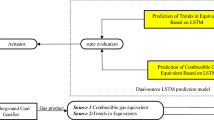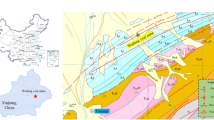Abstract
The change of gas emission or concentration level at the working face is one of the main precursor characteristics of coal and gas outburst. At present, coal and gas outburst monitoring and early warning are mainly based on whether it exceeds the limit and its change law. However, the gas concentration level is affected by factors such as coal seam gas content, permeability, and mining process, and the change law is complex to recognize manually. In this paper, the response characteristics of gas concentration level in the mining process are analyzed and revealed, and a bidirectional long short-term memory model is established. The change characteristics of the gas concentration level in the mining and non-mining processes are studied and recognized. The results show that the change law of gas concentration in the mining process has apparent periodicity and trapezoidal volatility. The proposed intelligent recognition method based on the bidirectional long short-term memory neural network can automatically recognize the underground mining and non-mining processes, and the recognition accuracy achieves \(97.7\mathrm{\%}\). The research can significantly help improve the level of coal mine safety management and the accuracy of early warning of coal and gas outburst.

















Similar content being viewed by others
References
Du F, Wang K, Zhang X, Xin C, Shu L, Wang G (2020) Experimental study of coal-gas outburst: insights from coal-rock structure, gas pressure and adsorptivity. J Nat Resour Res 29(4):2481–2493. https://doi.org/10.1007/s11053-020-09621-7
Wang E, Zhang G, Zhang C, Li Z (2022) Research progress and prospect on theory and technology for coal and gas outburst control and protection in China. J China Coal Soc 47(01):297–322. https://doi.org/10.13225/j.cnki.jccs.yg21.1846
National Mine Safety Administration (2022) National mine safety administration on notice on strengthening prevention of coal and gas outburst. https://www.chinamine-safety.gov.cn/ (Published 6 July 2022)
Qiu L, Li Z, Wang E, Liu Z, Ou J, Li X et al (2018) Characteristics and precursor information of electromagnetic signals of mining-induced coal and gas outburst. J Loss Prev Process Ind 54:206–215. https://doi.org/10.1016/j.jlp.2018.04.004
Wang Y, Liu L, Fu H, Xu Y (2018) Research on acoustic emission multi-parameter time series based prediction of gas outburst. J China Saf Sci J 28(05):129–34. https://doi.org/10.16265/j.cnki.issn1003-3033.2018.05.022
Wang A, Song D, He X, Dou L, Li Z, Zu Z et al (2019) Investigation of coal and gas outburst risk by microseismic monitoring. J PLoS One 14(5):20. https://doi.org/10.1371/journal.pone.0216464
Wang C, Wei L, Hu H, Wang J, Jiang M (2022) Early warning method for coal and gas outburst prediction based on indexes of deep learning model and statistical model. J Front Earth Sci 10:17. https://doi.org/10.3389/feart.2022.811978
Li Z, Jiang Y, Zhu W (2012) Mine gas wireless monitoring and forecasting network based on support vector machine. C 2nd International Conference on Engineering Materials, Energy, Management and Control; Mar 17–18; Wuhan, PEOPLES R CHINA. STAFA-ZURICH: Trans Tech Publications Ltd. https://doi.org/10.4028/www.scientific.net/AMR.424-425.232
Dong D, Wang H, Jia P (2012) Mine gas concentration pre-warning based monitoring data relational analysis. C 2nd International Conference on Chemical, Material and Metallurgical Engineering (ICCMME 2012); Dec 15–16; Kunming, PEOPLES R CHINA. STAFA-ZURICH: Trans Tech Publications Ltd; 2013. https://doi.org/10.4028/www.scientific.net/AMR.634-638.3655
Wu H, Shi S, Lu Y, Liu Y, Huang W (2020) Top corner gas concentration prediction using t-distributed Stochastic Neighbor Embedding and Support Vector Regression algorithms. J Concurr Comput-Pract Exp 32(14):10. https://doi.org/10.1002/cpe.5705
Hou P, Xue Y, Gao F, Wang S, Jiao X, Zhu C (2022) Numerical evaluation on stress and permeability evolution of overlying coal seams for gas drainage and gas disaster elimination in protective layer mining. J Mining Metall Explor 39(3):1027–1043. https://doi.org/10.1007/s42461-022-00584-2
Qiu L, Peng Y, Song D (2022) Risk prediction of coal and gas outburst based on abnormal gas concentrationin blasting driving face. J Geofluids 2022:1468–8115. https://doi.org/10.1155/2022/3917846
Bassam A, Santoyo E, Andaverde J, Hernandez JA, Espinoza-Ojeda OM (2010) Estimation of static formation temperatures in geothermal wells by using an artificial neural network approach. J Comput Geosci 36(9):1191–1199. https://doi.org/10.1016/j.cageo.2010.01.006
Sun J, Niu Z, Innanen KA, Li JX, Trad DO (2020) A theory-guided deep-learning formulation and optimization of seismic waveform inversion. J Geophysics 85(2):R87–R99. https://doi.org/10.1190/geo2019-0138.1
Thiele C, Araya-Polo M, Alpak FO, Riviere B, Frank F (2017) Inexact hierarchical scale separation: a two-scale approach for linear systems from discontinuous Galerkin discretizations. J Comput Math Appl 74(8):1769–1778. https://doi.org/10.1016/j.camwa.2017.06.025
Barros-Daza MJ, Luxbacher KD, Lattimer BY, Hodges JL (2022) Fire size and response time predictions in underground coal mines using neural networks. J Mining Metall Explor 39(3):1087–1098. https://doi.org/10.1007/s42461-022-00580-6
Gu Q, Xue B, Song J, Li X, Wang Q (2022) A high-precision road network construction method based on deep learning for unmanned vehicle in open pit. J Mining Metall Explor 39(2):397–411. https://doi.org/10.1007/s42461-022-00548-6
Bao W, Chu F, Shang C, Chen T, Wang F, Gao F et al (2021) A safe control scheme for the dense medium coal separation process based on Bayesian network and active learning. C 33rd Chinese Control and Decision Conference (CCDC); May 22–24; Kunming, PEOPLES R CHINA. NEW YORK: Ieee; 2021. https://doi.org/10.1109/CCDC52312.2021.9601924
Greff K, Srivastava RK, Koutnik J, Steunebrink BR, Schmidhuber J (2017) LSTM: a search space Odyssey. J IEEE Trans Neural Netw Learn Syst 28(10):2222–2232. https://doi.org/10.1109/TNNLS.2016.2582924
Le T, Vo MT, Vo B, Hwang E, Rho S, Baik SW (2019) Improving electric energy consumption prediction using CNN and Bi-LSTM. J Appl Sci Basel 9(20):12. https://doi.org/10.3390/app9204237
Nelson DMQ, Pereira ACM, de Oliveira RA et al (2017) Stock market’s price movement prediction with LSTM neural networks. C International Joint Conference on Neural Networks (IJCNN); May 14–19; Anchorage, AK. NEW YORK: Ieee; 2017. https://doi.org/10.1109/IJCNN.2017.7966019
Shahid F, Zameer A, Muneeb M (2020) Predictions for COVID-19 with deep learning models of LSTM, GRU and Bi-LSTM. J Chaos Solitons Fractals 140:9. https://doi.org/10.1016/j.chaos.2020.110212
Cheng Q, Chen Y, Xiao Y, Yin H, Liu W (2022) A dual-stage attention-based Bi-LSTM network for multivariate time series prediction. J J Supercomput 78(14):16214–16235. https://doi.org/10.1007/s11227-022-04506-3
Schuster M, Paliwal KK (1997) Bidirectional recurrent neural networks. J IEEE Trans Signal Process 45(11):2673–2681. https://doi.org/10.1109/78.650093
Ramcharan A, Baranowski K, McCloskey et al (2017) Deep learning for image-based cassava disease detection. J Front Plant Sci 8:1852. https://doi.org/10.3389/fpls.2017.01852
Jiang H et al (2018) Noise reduction analysis of rolling bearing vibration signal based on time domain synchronization. C 11th International Conference on Intelligent Computation Technology and Automation (ICICTA); Sep 22–23; Changsha, PEOPLES R CHINA. NEW YORK: Ieee; 2018. https://doi.org/10.1109/ICICTA.2018.00034
Zhong Y, Fei F, Liu Y, Zhao B, Jiao H, Zhang L (2017) SatCNN: satellite image dataset classification using agile convolutional neural networks. J Remote Sens Lett 8(2):136–145. https://doi.org/10.1080/2150704X.2016.1235299
Berrar D (2019) Cross-validation. J Ref Module Life Sci 2019. https://doi.org/10.1016/B978-0-12-809633-8.20349-X
Jiang P, Chen J (2016) Displacement prediction of landslide based on generalized regression neural networks with K-fold cross-validation. J Neurocomputing 198:40–47. https://doi.org/10.1016/j.neucom.2015.08.118
Rodriguez JD, Perez A, Lozano JA (2010) Sensitivity analysis of k-fold cross validation in prediction error estimation. J IEEE Trans Pattern Anal Mach Intell 32(3):569–575. https://doi.org/10.1109/TPAMI.2009.187
Markoulidakis I, Rallis I, Georgoulas I et al (2021) Multiclass confusion matrix reduction method and its application on net promoter score classification problem. J Technol 9(4):81. https://doi.org/10.3390/technologies9040081
Tharwat A (2020) Classification assessment methods. J Applied Computing and Informstics 2020. https://doi.org/10.1016/j.aci.2018.08.003
Deng X, Liu Q, Deng Y, Mahadevan S (2016) An improved method to construct basic probability assignment based on the confusion matrix for classification problem. J Inf Sci 340:250–261. https://doi.org/10.1016/j.ins.2016.01.033
Funding
This work was supported by the National Natural Science Foundation of China (52174218, 51774280); and the Science and Technology Planning Project of Guizhou Province, China (No. [2022] General 078). The authors gratefully acknowledge the financial support of the above-mentioned agencies.
Author information
Authors and Affiliations
Corresponding author
Ethics declarations
Conflict of Interest
The authors declare no competing interests.
Additional information
Publisher's Note
Springer Nature remains neutral with regard to jurisdictional claims in published maps and institutional affiliations.
Rights and permissions
Springer Nature or its licensor (e.g. a society or other partner) holds exclusive rights to this article under a publishing agreement with the author(s) or other rightsholder(s); author self-archiving of the accepted manuscript version of this article is solely governed by the terms of such publishing agreement and applicable law.
About this article
Cite this article
Du, Z., Liu, X., Wang, J. et al. Response Characteristics of Gas Concentration Level in Mining Process and Intelligent Recognition Method Based on BI-LSTM. Mining, Metallurgy & Exploration 40, 807–818 (2023). https://doi.org/10.1007/s42461-023-00757-7
Received:
Accepted:
Published:
Issue Date:
DOI: https://doi.org/10.1007/s42461-023-00757-7




